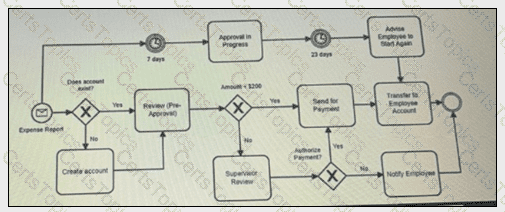iSQI Related Exams
CTFL-AcT Exam







As a part of a travel expense reimbursement management system, the following business process is defined:
• After receipt of the expense report, a new account must be created if the employee does not already have one. The report is then reviewed.
• Amounts less than $200 are automatically approved, while amounts equal to or greater than $200 must be approved by the supervisor. If the request is rejected, the employee is informed. The employee is reimbursed by payment to his of her bank account.
• If the request is not processed within 7 days, the employee receives an "ongoing" e-mail. If the request is not completed within 30 days, then the process is stopped, and the employee receives a cancellation e-mail asking her/him to resubmit the refund request
The following BPMN model has been submitted for review
Which of the following comments is MOST Likely to have been made on this BPMN model?

Which one of the following statements BEST explains how the quality of requirements / user stories and acceptance criteria affects acceptance testing?
In a project to develop an online booking system, the team decided to strengthen collaborative work between the business analyst and the testers working on the project. Several concrete joint activities have been identified.